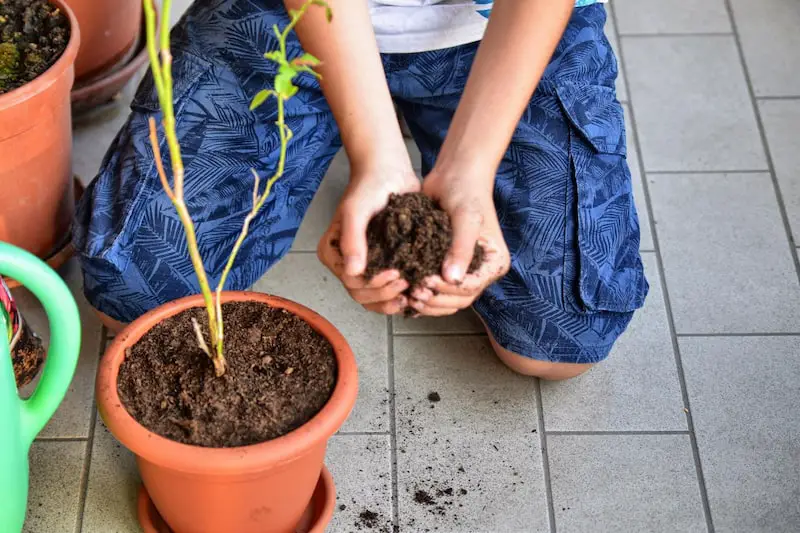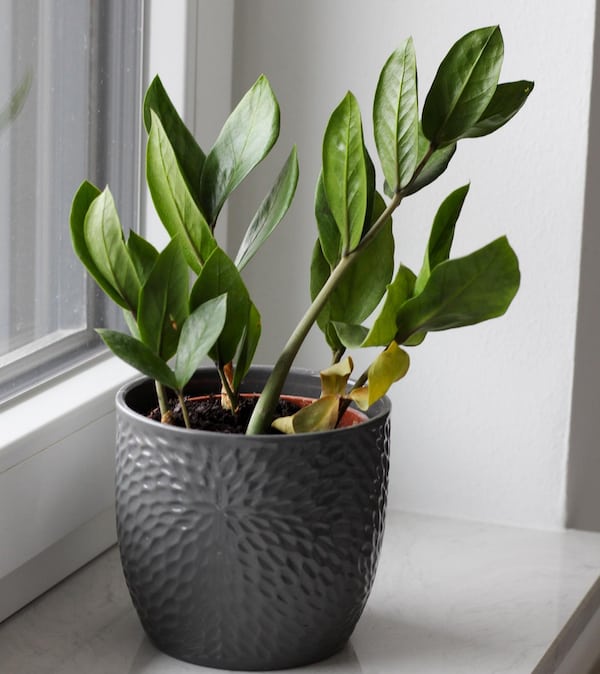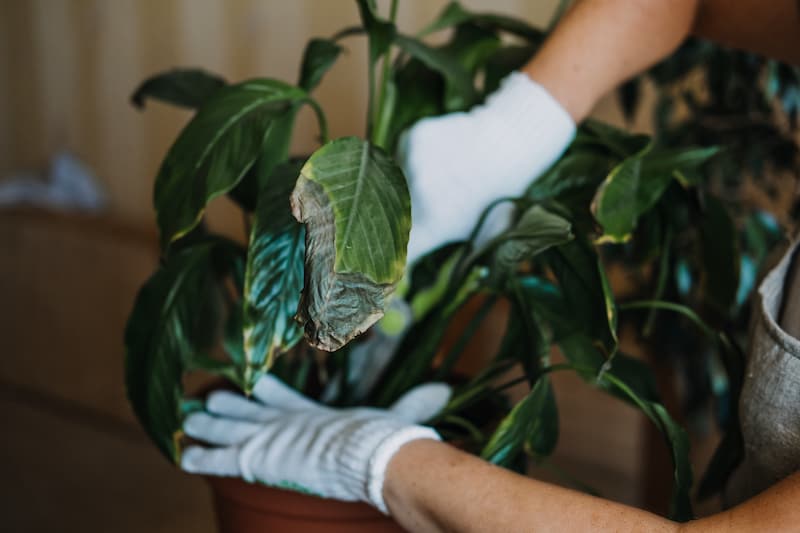Plants need to be watered properly. Overwatering causes problems for the plant. When watering, make sure you don’t overdo it. If you do, then the soil will become wet and cause problems for the plant.
To avoid your houseplants continuing to sit in overwatered soil, place the plant in areas where there is high wind, low humidity, or hot temperatures. These conditions will help the plant to dry out the soil.
You should never overwater plants. Drying soil is very important if you want to save your plants’ lives.
This article lists some signs of an overwatered plant, the top methods to dry overwatered soil, and the issues that your plant might have.
- Related: Learn all about soil
Signs of an Overwatered House Plant
Plants need water to grow. Roots absorb water from the soil. When roots dry out, they shrivel up and die. Darker roots mean the plant requires more water. White roots mean the plant doesn’t need any water.
Leaves will turn yellow and/or brown as the overwatering affects them. Plants can also wilt if they’re getting too much water. Check for drooping yellow leaves caused by too much water.
Plants need water to grow, overwatering leads to stunted growth. The plant’s growth will slow and even lead to dath.
Overly moist soil can lead to fungal diseases. These diseases spread through the damp soil and the fungi enter the plant through its roots. Dark and black roots will indicate root problems, while healthy roots will appear lighter in color.
White mold can also build up, attracting gnats and causing the plant to smell.
Stick your finger an inch into the top of the soil to feel if the soil is dry or not. A soil moisture meter is also an easy way to determine how much water your soil needs.

How To Dry Overwatered Soil
Overwatered soil is not a hard problem to solve with these methods below. These methods will involve using sunlight and wind to dry overwatered soil.
It usually takes 1–3 days for overwatered soil to dry out depending on the method.
1. Stop Watering and Allow Time To Pass
If you’ve been overwatering, stop watering immediately. This will allow the excess water to evaporate or drain away naturally.
It may take several weeks before the soil dries out completely though with this method. So it’s best to combine it with another method below to encourage the evaporation.
2. Increase the Temperature
The higher the temperature, the faster the water will evaporate. A sunny area in your garden will dry out the soil quicker than a shady one.
Place the plant in a warmer location such as near a window or under a light shade cloth. That will help the soil dry out.
Be careful of how much you need to add water to plants depending on the season and climate. You won’t need to water as much in the winter months as you would during the spring and summer months.
3. Increase Air Circulation
Wind helps to circulate air around the plant, which also increases the rate at which the water evaporates.
Place the plant in a spot where there is a lot of wind. This could be near a fan or window. But be careful the wind isn’t vastly different from the current temperature in the environment or else the plant may experience shock.
4. Place Plants in a Low Humidity Area
Humid environments don’t dry out quickly because the air stays humid. If you place your plant in a room with low humidity, the water will evaporate and dry out quicker.
5. Remove Mulch, Wet Leaves and Debris From the Top of the Soil
Remove all mulch, wet leaves and debris from the top of the soil. This will increase the airflow and make sure the soil dries out more easily. Water will be able to evaporate into the air.
Mulch keeps the soil cool and prevents the soil from drying quickly enough. The moisture is trapped underneath the mulch and keeps the soil moist. The same thing happens with any wet leaves or debris that’s on top of the soil.
6. Aerate the Soil
Similar to increasing air circulation around the plant, aerating the soil increases air circulation to help soil dry out.
Soil can become compacted. Moisture will have trouble escaping and roots will also have trouble absorbing water and nutrients. It’s best to aerate the soil to avoid compacted soil.
This involves breaking up the compacted soil with a stick or chopstick, so oxygen can reach the roots and allow water to evaporate. It’s important to aerate the soil regularly to prevent the growth of disease-causing bacteria.
7. Ensure There Are Drainage Holes at the Bottom of Your Plant
Water doesn’t collect at the base of a plant pot if there are multiple drainage holes. When watering plants, make sure excess water is escaping through the drainage holes.
You should make sure that there aren’t any rocks or other materials blocking your drainage holes. This will help prevent water from getting trapped in the soil.
8. Use a Hairdryer to Dry the Soil
Using a hair dryer directly on the soil can also be an easy way of removing excess moisture.
But directing the dryer at the soil will only remove the moisture on the surface of the soil, while the rest of the soil is still wet.
You’ll want to remove the plant and soil from the pot, and spread the wet soil out to dry. Be careful with putting the hair dryer too close to the soil and making it too hot.
The hot air can potentially damage the roots of the plant and kill beneficial microorganisms in the soil.
9. Use Lime to Dry the Soil
Lime is usually used on garden soil to dry the overwatered soil. Digging it into and mixing it with the garden soil will help dry out the soil.
Signs and Symptoms of an Overwatered Plant and Soil
It’s important to know the signs of what an overwatered plant looks like, so you’ll know that you need to dry the overwatered soil and treat the plants.

These are the most common signs of overwatering:
- Yellowing Leaves and Leaf Tips – Leaves and leaf tips turn yellow when they’re overwatered. They can also turn brown depending on the plant.
- Drooping Leaves – Plants droop when their root system has too much water and is unable to absorb the proper nutrients.
- Stunted Growth – When plants grow slowly, it’s usually because of overwatered soil or lack of sunlight.
- Dark Spots on the Leaves – Dark spots can also indicate that it’s too wet.
- Dead Roots – When the roots are dead, the plant won’t be able to absorb water and nutrients.
- Cracked Pot – Cracks at the bottom of the pot can also be caused by overwatering and the pressure from the water.
- Fungal Infections – Fungi thrive in moist environments. If the soil becomes too damp, fungi will start growing in the soil, which can cause diseases.
Fix Issues With an Overwatered Plant
If you notice these symptoms in your plants, then it’s time to fix them. Depending on the problems your plant is experiencing, you’ll use different treatment methods.
No matter the issue, you’ll need to stop watering first before doing anything else. You don’t want to add more water than the plant needs.
Treating Mild Cases of Overwatering
If your plant is experiencing early signs of overwatering, you won’t need to perform any drastic treatments. Using the various methods of drying the soil above might be all you need. Follow these steps:
- Check for and clear debris in the pot’s drainage holes, so excess water can leave.
- Tilt the pot, so the excess water drains away.
- Empty the cache tray (if there’s water inside) and check again.
- Plants need sunlight to grow. When plants get too much sun and direct sunlight, they may burn.
- Don’t let them get too hot because this could cause damage.
- Give them some fertilizer when needed. Increase air circulation to speed soil dryness. You don’t want the plant in a draft.
- Make sure the plant is in an area with good air circulation.
- Lower the ambient humidity level to allow the water to dry.
- If you’re using trays or a humidifer, stop using them until the plant is out the danger zone.
Watering it too much is very easy. Take extra precautions, and if you’re unsure, wait before watering.
Treating Stressed Plants
Overwatering causes plants to get stressed, and this leads to problems such as brown tips. Moving the plant away from direct sunlight or bright lights helps the plant recover.
Remove the top part of the plant, including the buds, flowers, and fruits. This conserves energy.
Avoid fertilization until you see new growth. Don’t aerate too much, because it could damage the roots.
If the soil is very wet, remove it from its pot and place it on a paper towel or other dry absorbent material. If the soggy soil can’t be saved, replace it with fresh soil in the pot.
Use a fan to help increase air circulation around your plants. Dehumidifiers can also work well, but you need to watch them carefully, so the soil doesn’t dry out completely.
Aerate the soil before planting. Mix up some dry material in the soil. Remove the pot and gently clean off the old soil. Add fresh soil around the root ball.
Repotting is done when plants get too large or if you want to change the soil mixture. Pruning is needed to remove dead tissue. You should also check your plants for any diseases at the same time.

Treating Root Rot
Indoor plants are prone to root rot. The problem occurs when the roots become infected with fungi. It usually happens due to improper watering, overfertilizing, poor air quality, and overcrowded pots.
It usually starts with yellow leaves and ends with wilted foliage. The best way to prevent root rot is to keep the soil evenly moist.
Moldy soil should be wiped off or washed off with water. Infected roots should be cut away carefully without breaking them.
Yellow leaves should be trimmed back to the same size as the root system, or the roots won’t be able to support the leaves on the plant.
After replacing the infected soil with fresh, dry soil, be careful when resuming a watering schedule. Adjust it so you don’t end up with waterlogged soil and damaged plant roots again.
How to Prevent Overwatered Soil
Overwatering causes problems that are best avoided. Preventing overwatering is the best way to keep a garden of healthy plants.
Here are the top tips to prevent overwatering:
- Check the soil before watering. If the soil is still moist, you don’t need to add water.
- Make sure there’s no standing water in the bottom tray.
- Ensure the plant is in a pot with drainage holes that are not clogged.
- Make sure there are air pockets in the soil for good aeration.
- Use fresh potting soil when necessary. Don’t reuse soil where a fungal disease once resided.
- Don’t let the soil get too cold. Cold weather slows down the rate of evaporation.
- Keep the soil moist, but not saturated. Moisture levels vary depending on the type of plant.
Dry Overwatered Soil Final Thoughts
All in all, overwatering is one of the worst gardening mistakes. But, fortunately, it can easily be prevented. By following the tips above, you’ll be able to avoid overwatering and keep your plants happy and healthy.


Bringing in outdoor plants for the winter keep them growing? I have beautiful begonias. I notice they smell when you water them. Even indoor plants, is it a good idea if you don’t have great lighting areas?
Bringing your begonias indoors can help them survive the winter, but not necessarily grow all that much because it’ll depend on many other conditions. The scent during watering is normal, but if it’s foul, check for overwatering or poor drainage. Begonias generally require bright, indirect light. If you don’t have great natural lighting, you might want to invest in grow lights. Water less frequently than outdoors and keep the temperature around 60-70°F. Watch out for pests and increase humidity if your home is dry. With proper care, your begonias can overwinter inside until spring.